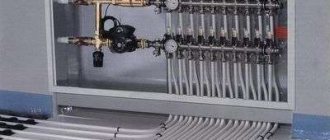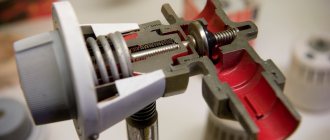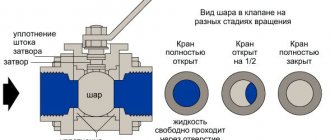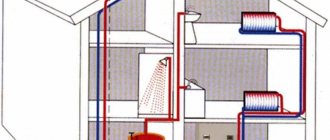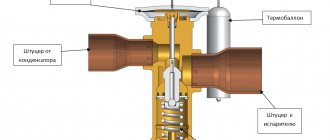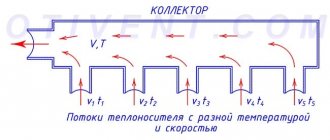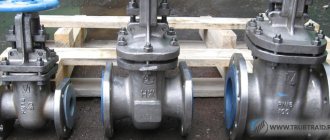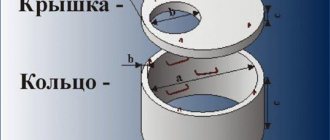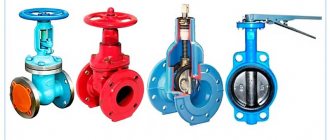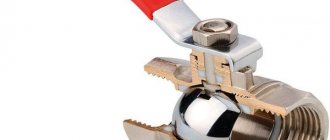One of the common problems with heating systems both in the private sector and large apartment buildings is incomplete heating of the radiators due to air accumulated in them. To quickly and easily solve this defect, a special valve was designed - the Mayevsky tap.
What is a Mayevsky crane?
In order to understand why a Mayevsky tap is needed, it is worth understanding the operating features of the heating system. A certain number of air bubbles are dissolved in the water that fills the heating devices. When they come together, they can form an air lock, preventing the battery from heating evenly and preventing the system from functioning properly. The problem can be solved by completely draining the fluid and refilling the system.
At the beginning of the 20th century, a plumber from Minsk named Roev invented the first primitive device with which it was possible to remove excess air from the battery without draining the water. A few years later, designer Ch.B. Mayevsky modified the valve. He increased its tightness, changed the structure to “cone to cone” and added a safe key to operate the system. This is how the Mayevsky crane appeared, which is now widely used when installing heating in offices and apartments.
Design of the Mayevsky crane
The official names of the device, which are mentioned in various documents, are a radiator needle air valve or a device for releasing air from radiators. Regardless of the name under which the mechanism is used, its design is simple, therefore, not only professional plumbers, but also ordinary users of residential and office premises know what a Mayevsky faucet looks like. The valve consists of:
- A housing that is made of metal or plastic.
- Rotating part.
- A conical screw with a head for a special key and thread for a screwdriver.
- Inlet calibration channel for air.
- An outlet channel with a hole of about 2 mm to remove air accumulated in the system.
Operating principle of the Mayevsky crane
Thanks to the structural features of the Mayevsky valve, it completely copes with removing excess air from the system without leaking coolant. The principle is a little similar to the operation of a conventional water mixer, after opening the valve, water flows. However, the system of how the Mayevsky crane works is somewhat more complicated:
- The valve is installed in the upper part of heating devices.
- The device is adjusted by a special locking screw, which can be driven with a special key or screwdriver.
- After turning the screw, a special plug opens, moving the air in the system.
- The air accumulates in a special sealed chamber of the device, separated by a cuff into which water cannot penetrate.
- Oxygen is discharged out through special grooves in the propeller body.
Advantages and disadvantages of ball valves
Ball valves are very popular in a wide variety of industries. They are considered reliable shut-off devices and are part of the water supply system of city apartments and private houses.
In addition to reliability and simplicity of design, products of this type have many other advantages:
- long working life, long service life;
- rarely break down, easy to repair;
- high degree of tightness; if installed correctly, there are no leaks;
- convenient to use, turning or pressing the lever is enough to shut off the water flow;
- a huge range of sizes and types;
- Easy to install, you can install it yourself without involving a plumber.
Ball valves have no disadvantages, they are affordable, and every hardware store will offer you a choice of several products of various sizes.
A mixer with a ball mechanism will relieve its owners from labor-intensive and frequent replacement of gaskets, as well as problems with water leakage, which are so often found with outdated valve taps.
Ball mixers very rarely fail; the main cause of failure is hard water, so manufacturers recommend installing water filters in the water supply system
Types of Mayevsky crane
Almost 100 years have passed since the invention of the valve, and the concept of what a Mayevsky valve is has changed somewhat thanks to the achievements of modern designers. In a specialized store you can find three types of such a device:
- An ordinary manual tap that can be used to eliminate defects in the heating system as needed.
- Mayevsky's automatic faucet on heated towel rails and other equipment removes excess air in autonomous mode.
- A system with a safety valve against possible water hammer.
The devices differ in the material from which the main elements are made. Can be used:
- stainless steel;
- brass;
- cast iron;
- durable plastic.
The designs and type of locking mechanism differ:
- special screw with a slot for a screwdriver;
- 4- or 6-point key screw;
- non-removable handle that can be unscrewed without the use of tools.
Mayevsky manual crane
Initially, Mayevsky's manual tap was invented for cast iron radiators. This device has the simplest design and low price, due to which it is still used everywhere. The principle of its use is simple:
- The master or owner of the premises independently determines the uneven heating of the battery.
- Using a special key or screwdriver, the shut-off valve is turned, after which air begins to escape from the battery.
- Once the air flow ends, the valve rotates to the sealed position.
- The next time the system is aired, the operation is repeated.
Mayevsky automatic crane
A more convenient version is Mayevsky’s automatic battery-powered faucet, which is often installed in private homes with an individual heating system. The device operates offline according to the following principle:
- The cylindrical brass device is made with an additional chamber with a float, which is connected to a needle valve.
- When air enters the system, it moves a float, which opens the shutter valve.
- When air is removed, the float lowers and the valve closes automatically
- That is, the device works without human intervention. This device is more convenient to use, but it is significantly more expensive than its manual counterpart.
Mayevsky tap with safety valve
In relatively fragile heating systems made of polypropylene or metal-plastic, it is recommended to install an improved Mayevsky manual tap for heated towel rails with a safety valve that protects heating equipment components from water hammer. In such a device, when the coolant pressure in the system increases above 15 B, the safety valve is activated. This begins bleeding water from the system to compensate for the increased pressure.
How is the air exhaust mechanism installed?
The Mayevsky manual tap is a self-sealing device. The product kit includes an O-ring made of rubber, so there is no need to use any additional sealing materials.
Traditionally, the installation of manual valves for bleeding air of this type is performed in conjunction with radiator fittings (1 dm x ½ dm; 1 dm x ¾ dm). As an installation tool, use a spanner wrench specially designed for working with fittings and plugs.
Plumbing socket wrench for installing radiator casings and plugs. 1 – ring wrench, 2 – radiator cap, 3 – radiator cap. These tools and parts are often used when installing air vent valves
The operation of Mayevsky valves (air vents) is permissible only at the pressure and temperature values specified in the standards. These values are determined by the technical characteristics of the device.
How to choose a Mayevsky crane?
After finding out what a Mayevsky crane is and for what purpose the device was developed, it is worth taking a closer look at the rules for choosing a unit. They are based on the features of a specific heating system:
- In central heating systems with relatively contaminated water and high pressure of about 15 At, it is not recommended to install such a device. In private homes you cannot do without such a valve.
- The diameter of the coupling of the selected model must completely coincide with the diameter of the radiator. Otherwise, the unit simply cannot be connected.
- The material used affects the quality and durability of use. Many professionals recommend purchasing brass alloy products. To enhance its aesthetic appearance, the main device can be hidden in a plastic cap.
- The choice of a Mayevsky crane is also based on the type of control. Automatic devices are more convenient, but more expensive. Manual models may have a special removable rotary key or a stationary handle to operate the shut-off valve.
How to ventilate batteries in a private home
The autonomous heating system of a private house differs significantly from a centralized heating network. The fact is that the owners of their houses turn to specialized enterprises for the installation of a heating system. Professionals use design documentation that provides for the installation of an expansion tank.
Ventilation system for autonomous heating communications of a private house
The tank is installed at a point that is higher than the entire heating system. Containers can be open or closed. In the first case, airing of the system is eliminated by simply adding coolant to the expansion tank. The closed tank is equipped with a release valve.
Closed expansion tank
The system is mounted in such a way that air pockets are squeezed out of the radiators and lifted into the expansion tank.
When the heating temperature of the coolant increases, the air collected in the tank leaves the container through the open valve.
Ventilation of the heating system of a private house.
How to install a Mayevsky crane?
To ensure uninterrupted and proper operation of the entire heating system, the air exhaust device must be installed on:
- all radiators included in the system.
- loop capacitors;
- heating coils and register.
A plumber can professionally install the device, although if you have certain knowledge, the owner of the premises can also cope with the work. The basic installation rules are:
- It is better to install the Mayevsky tap on a cast iron radiator in the warm season, when it is possible to completely drain the water.
- All radiators are removed from the hooks and freed from coolant.
- According to the installation rules for the Mayevsky tap, its installation is carried out at the top point of the radiator, on the opposite side from the pipe inlet.
- If installation of additional equipment is not provided in the top plug, then drill a hole equal in diameter to the air vent valve.
- Install the equipment with the outlet pointing down and away from the wall. If installation is carried out on plastic pipes, a special fitting will be required.
- The radiator is returned to its place, connecting to the pipeline.
- The system is filled and ventilated.
Key for Mayevsky crane
To use manual models of equipment, a special key or valve is required. It comes complete with the mechanism itself and most have a typical design with a rectangular cross-section. When the valve is turned, the valve begins to bleed air from the system. However, it is not uncommon for the key to be lost or left with the previous owners of the premises, and the new owners do not know how to open the Mayevsky tap. In this case, in any hardware and specialty store you can purchase a standard key suitable for most models from:
- durable polymer;
- metal
Technical characteristics of the air vent
The required functional properties are presented in the following table:
| Technical specifications | Permissible value | Units |
| Pressure (working) | 10 | ATI |
| Temperature (maximum) | 120 | ºС |
| Passage diameter | 25.4 or 20.0 | mm |
| Thread diameter | 25.4 or 20.0 | mm |
| Working environment | water and other non-aggressive liquids | – |
| Life time | 20 – 25 | years |
| Leakage class | "A" | – |
During operation, malfunctions in the operation of the devices cannot be ruled out. A frequent reason for the loss of performance of Mayevsky cranes is small debris moved by the coolant.
If the faucet becomes clogged and no longer works, it is recommended to carry out simple maintenance:
- Isolate the radiator from the system with shut-off valves.
- Release approximately 1/3 of the water volume from the battery.
- Remove the device from the battery case.
- Clean the passage hole with a thin (non-metallic) sharp object.
Heating systems are not always equipped with radiators that have plugs with ready-made holes for Mayevsky taps. In such cases, the terminals for the air vents will have to be made by hand. No particular difficulties are foreseen in this matter. You just need to drill a hole for the installation size of the faucet and cut the thread.
The installation of taps in the housing of cast iron heating radiators should be given special attention. Products made from high-quality, reliable materials are traditionally used here.
The hole is drilled with a metal drill using a drill, and the thread is cut with a tap. Of course, the diameter of the drill is chosen 1 - 1.5 mm less than the installation size of the faucet, and the tap is exactly the size.
Mayevsky tap - how to bleed air from the battery?
With the onset of cold weather, instructions on how to use the Mayevsky tap will be useful to many homeowners. The device is used in the following sequence:
- Turn off all pumps that increase the circulation of coolant in the system.
- Turn the key or valve to open the shut-off valve counterclockwise.
- After turning, air will begin to escape from the system with a characteristic hissing sound. There may be slight drops or splashes of warm water, so you can place a container or cloth under the device.
- The completion of the process will become clear by a uniform stream of water supplied without pressure or hissing.
- At this moment the valve is closed.
- After a few minutes, check that the battery is warming up evenly.
How to open the Mayevsky tap without a key?
If the instructions on how to bleed air from a particular Mayevsky tap do not include the use of a special key, or it is lost, then you should use the following methods:
- The rotary mechanism may have a special slot for a flat-head screwdriver. If there is one, then the screwdriver is inserted into the groove and carefully turns the mechanism in the desired direction.
- You can try to turn the valve with an adjustable wrench or pliers, which in some cases can replace a special wrench.
Features of operation
Let's look at how to use the Mayevsky crane at work. First, place some container under the radiator and prepare a dry rag. Using a special key or a simple screwdriver, turn the locking screw. In this case, you need to turn counterclockwise and half a turn. The air will start to come out, and then the water will come out. You need to wait until the liquid flows without interruption. After this, tighten the screw.
A case where the air has been removed but the radiator remains cold indicates a clogged system.
In order to clean a clogged battery, you need to seek help from a plumber.
Note: If the heating system has a pump operating on the principle of forced circulation, then it will need to be turned off 10 minutes before the air lock is released. If the pump is turned on, the water flow will distribute air throughout the system and it will not accumulate in the upper part of the battery.
If the hole in the Mayevsky tap is clogged, you can try to clean it yourself with a sharp object. Also, if the tap is not used for a long time, the adjusting screw will be difficult to rotate due to possible corrosion formations. If such a problem occurs, use a product such as WD-40 spray lubricant. It works very quickly and makes it easy to unscrew the screw.
Also, at the end of the heating period, the screw should be lubricated. In this case, there will be no destruction of the thread under the influence of the coolant.
If there is a need to replace the Mayevsky tap, you need to use two adjustable wrenches. One key holds the radiator cap, and the second unscrews the valve. If this is not observed, then when unscrewing the tap, the plug may loosen, which will lead to a leak.
If you take care of this device, do routine diagnostics and cleaning, it will last a long time without any problems.
Mayevsky's faucet does not bleed - what to do?
In some situations, if the Mayevsky valve is installed on an old cast-iron battery, then after opening the valve, air discharge may not occur. In each situation, solving the problem must be approached comprehensively, alternately checking one of the methods presented below:
- The valve does not open due to a rusted connection. Then you can try to lubricate this place with kerosene or special automotive lubricant, waiting 2-3 minutes. After this, you can try to turn the valve again, but carefully so as not to strip the thread.
- Perhaps the air outlet hole is clogged with dirt particles from the coolant or rust. Then you need to unscrew the stem and try to clean it with a thin metal wire with a curved end or a regular sewing needle. At the moment of supplying air and water, it is important to have time to tighten the rod and place a container for draining.
The Mayevsky tap is leaking - what to do?
In a working valve, there is no possibility of water leakage in either the open or closed state. A special rubber seal is responsible for the tightness. If, however, drops periodically appear from the air release valve, you can use one of the following methods to eliminate the leak:
- If drops appear in the thread area, then you can try tightening the device itself with a wrench to the radiator by about 10-20%.
- Perhaps the leakage problem lies in clogged internal threads and excess pressure on the device. Then the entire system can be removed (after draining the water), cleaned with a brush and put back in place.
- If the problem is the wear of the rubber seal, then it is easier to replace the valve with a new one.
How to replace the Mayevsky tap?
There are alternative options for getting rid of air locks in the heating system. A replacement for the Mayevsky tap on the battery can be:
- A conventional ball valve installed at the top of the radiator. However, when it is opened, a significant portion of the coolant may leak out.
- An air separator, which is installed on pipes near the boiler. This device is capable of independently differentiating dissolved gases from the coolant and removing them through an air vent. An additional advantage of the device is the purification of water from sand, rust and other slags and impurities.
Causes and signs of air locks in the heating system
The appearance of air pockets inside radiators is primarily associated with the startup of the heating system at the beginning of the heating season and after its overhaul. But practice shows that airing can occur during intensive use of the heating network. There are several reasons for this:
- unplanned repair work (assembly and disassembly) of heating system elements;
- overheating of the coolant, resulting in the release of gases that will air the batteries;
- use of contaminated coolant with air impurities;
- adding additional water to the system;
- connection points of radiator elements and pipelines begin to let water through;
- When installing the heating system, the radiator collectors were not horizontal;
- lack of automatic air bleeding;
- contamination of internal passages in radiators with rust;
- low pressure in hot water pipes.
Signs of airiness may include:
- Tactilely sense cold areas of the battery surface;
- The room temperature drops;
- In autonomous heating systems, an increase in fuel consumption becomes noticeable;
- In the radiators you can hear the coolant gurgling and babbling.
